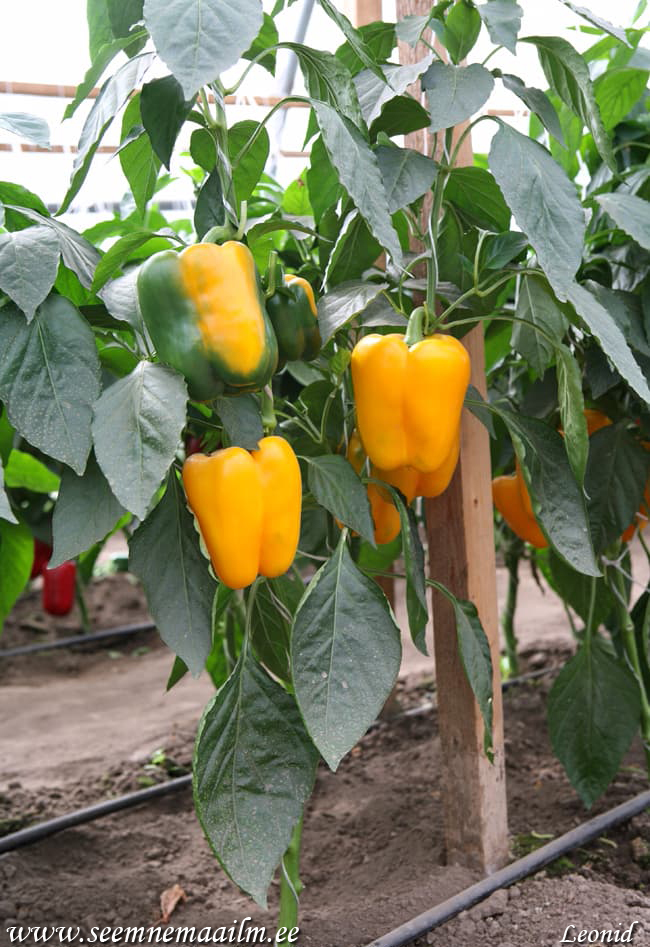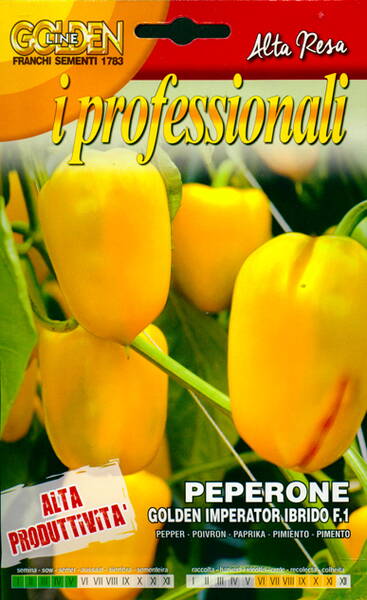Mid-early (107-114 days), high-yielding, large-fruited hybrid for protected ground.
The plant is medium-sized, powerful. The fruits are cuboidal and prism-cubic, 10 x 8-9 cm.
The color in technical ripeness is green, in biological ripeness it is rich yellow. Weight 160-240 g.
The pulp is tender, juicy, sweet. Wall thickness 8-10 mm. Possesses complex resistance to diseases.
The value of the hybrid: high content of sugars and vitamins, excellent taste and commercial properties of fruits, good transportability.
Recommended especially for fresh consumption and culinary processing.
The optimum soil temperature for seed germination is +26+29°C.
1.0 g = 150 seeds.

* Growing seedlings of pepper.
The key to the success of a good pepper harvest is the age and quality of the seedlings. Pepper seedlings are grown in two ways - with and without picking.
The method without picking is more attractive, as it does not cause much difficulty and accelerates the growth of young plants, which also take root better.
Taking into account the emerging opportunities at each site, sowing seeds for growing seedlings is usually carried out 50-60 days before planting them in a permanent place when grown with picking and 45-50 days without picking.
The main condition for obtaining good seedlings is the correct choice of substrate, which can consist of peat, fertile soil and humus. Composts, sawdusts, and mineral fertilizers are also used.
Before sowing, the seeds are placed in gauze bags and washed in clean, running water, then they are placed in a plastic bag without tying it and placed in a warm place for 12-14 hours. This method accelerates the swelling and germination of seeds. Seeds are sown in pots, boxes, or other suitable containers, to a depth of 0.5-1 cm, covered with a nutrient mixture on top and lightly compacted (when seeds are planted deeply, the seedlings are weak, and when planted shallowly, they dry out and appear over an extended period of time).
The crops are watered with warm water and covered with plastic film or glass so that the soil does not dry out. The boxes are placed in a warm place (+25+28 °C). After the shoots emerge, the film is removed, and the boxes or pots are placed closer to sunlight.
If the method of growing seedlings requires picking, then you should not be late with it, since overgrown seedlings take root less well when transplanted. Picking is carried out 15-20 days after emergence when the seedlings have 1-2 true leaves. The planted seedlings are shaded for the first two days, protected from the bright sun, so that the plants do not wither and take root better.
Excessively high temperature and air humidity when growing seedlings are undesirable, as it contributes to the elongation of plants, their “black leg” disease and slow development of the root system. Therefore, on warm sunny days you need to ventilate more often.
It should be watered not often, but abundantly. If the leaves do not show signs of wilting, then you should not rush to water. The dried soil surface is periodically loosened.
During the period of growing seedlings, it is advisable to carry out at least two feedings. For feeding, complex mineral fertilizer with microelements is used.
The seedlings are watered abundantly on the eve of planting. By the time the seedlings are planted, the plants should have 7-12 true leaves and small buds, 20-25 cm high.
Seedlings are planted in glass greenhouses at the end of April, in film greenhouses and greenhouses on May 10-25 (after the soil has warmed up to +18 ° C), and in open ground at the beginning of June (when the danger of frost has passed). It should be borne in mind that in case of cold weather, the plants must be covered with agrotextiles or perforated plastic film.












